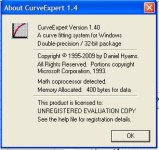Hello all, I am working on a project where I need to use data that is plotted on a graph that is nonlinear. To help clarify, this is an application where someone has ran an auger and determined that the auger dispenses a certain amount (lbs.) per RPM. The problem is that it is not linear, If it were I could just use a SCP. I need to figure out a way to import the data into the PLC so when the operator sets a given rate in lbs., the auger will know where to start. I hope this makes sense. Any suggestions would be appreciated. I am using RSLogix 5000.
Thanks
Thanks








